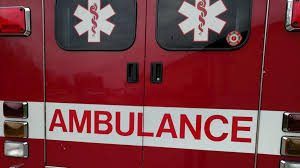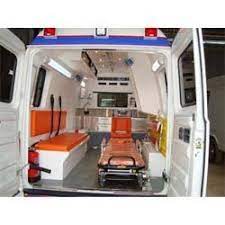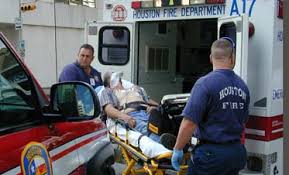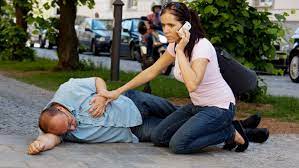Emergency Ambulance Services: When to Call, How to Call, and What to Expect
An ambulance is a specially equipped vehicle that is designed and used to transport sick or injured people to medical facilities such as hospitals. It is typically staffed with trained medical personnel, such as paramedics or emergency medical technicians, who can provide medical care en-route to the hospital. The ambulance is equipped with a variety of medical equipment, including a stretcher, oxygen tanks, a defibrillator, and other medical supplies. The vehicle may also be equipped with communication equipment such as radios or mobile data terminals to communicate with hospital staff and emergency services. In emergency situations, they can be dispatched to the scene of an accident or medical emergency to provide immediate medical attention and transport to the hospital. We will discuss the following topics:
Structure of an ambulance
Who works on an ambulance
What happens on an ambulance call
Things to tell the dispatcher when calling 911
Things to take with you when being transported by an ambulance
Can someone decline transport to a hospital
When To and When Not to Call an Ambulance
How to call an ambulance
Providing assistance while waiting for an ambulance
CPR
Tips to remember when calling for an ambulance
First aid

The structure of an ambulance is adaptable, varying based on the manufacturer and model. Generally, it’s crafted to ensure safety, comfort, and functionality for both medical staff and patients. Externally, ambulances typically use van or truck chassis, customized to accommodate an ambulance body. This body includes compartments, cabinets, and shelves for storing medical supplies. The exterior is often brightly colored with reflective striping for easy identification.
Internally, ambulances feature a primary compartment for patient transport, equipped with a stretcher, seating for medical personnel, and monitoring and treatment equipment. Additional storage compartments may house extra medical gear. Furthermore, there’s typically a separate compartment for the driver and passenger seats to ensure a clear division between medical and driving areas.
Other features that may be included in an ambulance can vary, but often include:

- Oxygen supply and delivery systems are used to provide supplemental oxygen to patients who are experiencing breathing difficulties or low oxygen levels. These systems typically consist of an oxygen tank, a regulator, and tubing that delivers oxygen directly to the patient’s nose or mouth.
- IV therapy equipment is used to administer fluids and medications directly into a patient’s veins. This equipment typically includes an IV catheter, tubing, and a bag or bottle of fluid.
- A defibrillator is a medical device used to deliver an electric shock to the heart in order to restore its normal rhythm. Defibrillators are used to treat cardiac arrest, a condition in which the heart suddenly stops beating.
- A cardiac monitor is a device used to monitor a patient’s heart rate and rhythm. This device typically consists of electrodes that are attached to the patient’s chest, which transmit electrical signals to a monitor that displays the patient’s heart activity in real-time.
- A blood pressure monitor is used to measure a patient’s blood pressure, which is the force of blood against the walls of the arteries. Blood pressure monitors typically consist of a cuff that is placed around the patient’s arm and a device that measures the pressure.
- Suction devices are used to remove fluids, such as blood or mucus, from a patient’s airway or from a wound. These devices typically consist of a tube and a suction pump.
- Ventilation equipment is used to assist a patient’s breathing when they are unable to breathe on their own. This equipment typically includes a mask or tube that delivers air or oxygen to the patient’s lungs.
- Lighting for patient examination and treatment: Good lighting is essential for examining and treating patients. Medical facilities typically use overhead lights, exam lights, and other types of lighting to ensure that patients are properly illuminated during procedures.
- Communication equipment, such as radios and mobile data terminals are used to ensure that medical personnel can communicate with each other and with emergency services. This equipment typically includes radios, mobile data terminals, and other types of communication devices.
- Climate control to maintain a comfortable environment for patients and medical personnel is used to maintain a comfortable environment for patients and medical personnel. This typically involves heating and cooling systems, as well as ventilation systems that help to maintain good air quality.
Overall, the structure of an ambulance is designed to provide a safe and effective environment for medical care and transport of patients in emergency and non-emergency situations.
An ambulance typically has a crew of two or more individuals who work together to provide medical care and transport patients to medical facilities. The specific roles and responsibilities of the crew can vary depending on the level of training and certification, as well as the regulations in the jurisdiction where the ambulance operates. They are trained to provide basic and advanced life support services, such as administering medications, performing advanced airway management, and providing CPR.
Here are some of the common roles on an ambulance crew:
- Emergency Medical Technician (EMT): trained and certified to provide basic life support (BLS) care, including administering oxygen, controlling bleeding, treating fractures, and providing other basic medical care.
- Advanced Emergency Medical Technician (AEMT): have additional training and certification beyond EMTs and can perform more advanced procedures such as administering intravenous (IV) fluids and medications, performing advanced airway management, and providing other advanced medical care.
- Paramedic: are the most highly trained and certified members of an ambulance crew. They have the training and equipment to provide advanced life support (ALS) care, such as performing advanced cardiac life support (ACLS) procedures, administering medications, and providing advanced airway management.
- Driver: responsible for safely operating the vehicle, navigating to the scene of the emergency or medical facility, and communicating with other emergency services as needed.
- Firefighters are types of emergency responders who work to provide aid and assistance during emergencies. Firefighters are typically responsible for responding to fires and other emergency situations that require specialized knowledge and training in fire suppression and rescue operations. They work to extinguish fires, rescue people from burning buildings or other hazardous situations, and provide basic medical assistance as needed. Firefighters may also be responsible for other duties, such as conducting fire safety inspections and providing education and outreach to the public.
In addition to the above roles, some ambulances may also have a supervisor or commander who oversees the operation of the ambulance and ensures that proper protocols are followed.

On an ambulance call, the crew will respond to a location where an emergency or medical situation has been reported. The specific actions taken by the crew will depend on the nature and severity of the situation, as well as the training and protocols of the ambulance service. Here are some general steps that may be taken during an ambulance call:
- Assessment and stabilization: Upon arrival, the crew will assess the patient’s condition and provide any necessary stabilization measures to ensure the patient’s vital signs are stable before transport. Depending on the situation, this may include administering oxygen, controlling bleeding, immobilizing fractures, or providing other basic life support care.
- Treatment and monitoring: The crew will continue to provide medical treatment and monitoring as needed during transport to the medical facility. This may include administering medications, providing advanced airway management, performing CPR or defibrillation, or providing other advanced life support care.
- Transport and handoff: Once the patient is stable and ready for transport, the crew will transport the patient to the designated medical facility. During transport, the crew will continue to monitor the patient’s condition and provide any necessary medical care. Upon arrival at the medical facility, the crew will provide a handoff report to the receiving medical staff, detailing the patient’s condition, treatment provided, and any other relevant information.
- Documentation and restocking: After the call is complete, the crew will document the care provided and restock any used equipment or supplies to ensure the ambulance is ready for the next call.
Overall, the goal of an ambulance call is to provide prompt and effective medical care and transport to the appropriate medical facility, ensuring the best possible outcome for the patient.
Things to tell the dispatcher when calling 911
When calling 911, it is important to provide the dispatcher with clear and accurate information about the emergency situation. Here are some important things to tell the dispatcher when calling 911:
- Location: Provide the exact address or location of the emergency, including any landmarks or cross streets that may help emergency services locate the scene.
- Nature of the emergency: Provide a brief description of the emergency, including what happened and whether anyone is injured or in need of medical attention.
- Number of people involved: Provide the number of people involved in the emergency, including any injured or sick individuals, as well as any potential witnesses or bystanders.
- Condition of the patient(s): Provide any information you have about the condition of the patient(s), including whether they are conscious, breathing, or have any visible injuries or medical conditions.
- Any hazards or safety concerns: Provide any information about any hazards or safety concerns at the scene, such as fires, explosions, or downed power lines.
- Any special needs or requests: If there are any special needs or requests, such as the need for an interpreter or the presence of a service animal, be sure to mention them to the dispatcher.
Remember, it is important to stay calm and speak clearly when talking to the dispatcher. Answer any questions they ask as accurately and thoroughly as possible to help emergency services respond quickly and effectively to the situation.
Things to take with you when being transported by an ambulance
If you need to be transported by an ambulance, there are certain items that you should bring with you to ensure that you have what you need during your journey and when you arrive at the hospital. Here are some things to consider bringing with you:
- Identification: Bring a government-issued ID, such as a driver’s license, passport, or state ID, to help medical staff verify your identity and medical history.
- Medical information: Bring any relevant medical information, such as a list of medications you are taking, allergies, medical conditions, or previous surgeries, to help medical staff provide appropriate care.
- Insurance information: Bring your insurance card and any other relevant information to help medical staff bill your insurance company for the services provided.
- Personal items: Bring any personal items that you may need during your stay, such as a change of clothes, toiletries, or phone charger.
- Medications: Bring any medications that you need to take regularly, as well as any rescue medications, such as an EpiPen or inhaler, in case of an emergency.
- Comfort items: Bring any comfort items that may help you feel more at ease during your journey, such as a favorite blanket or pillow.
Remember, space on an ambulance is limited, so bring only what you need and can carry easily. If possible, have a family member or friend gather these items for you before the ambulance arrives.
Can someone decline transport to a hospital
Yes, someone can decline transport to a hospital if they are conscious and able to make that decision. This is known as “refusing medical transport.” However, it is important to note that refusing medical transport may not be the best decision in all cases, particularly in the case of a medical emergency.
If someone is experiencing a serious medical condition, such as a heart attack or stroke, prompt medical attention is essential. In such cases, refusing medical transport could put the person’s health and even their life at risk.
Additionally, if a person has suffered an injury, they may not be aware of the extent of the injury or the potential complications that could arise without medical treatment. In such cases, it may be best to err on the side of caution and accept medical transport.
If a person decides to refuse medical transport, they will typically be asked to sign a form acknowledging their decision. Emergency medical services (EMS) personnel will also typically provide information and advice about seeking medical attention if the person’s condition worsens or if they develop new symptoms.
It is important to note that if the person is not conscious or is unable to make a decision, emergency medical services will generally transport them to the nearest hospital for treatment.

- Chest pain or pressure: Chest pain or pressure is a common symptom that can indicate a variety of medical conditions, including heart attack, angina, pulmonary embolism, or aortic dissection. It can be described as a feeling of tightness, heaviness, or pressure in the chest, and may be accompanied by shortness of breath, sweating, nausea, or lightheadedness.
- Difficulty breathing or shortness of breath: Difficulty breathing or shortness of breath is a condition in which a person feels that they cannot take in enough air or that their breathing is labored. This can be caused by a variety of medical conditions, including asthma, pneumonia, pulmonary embolism, or heart failure.
- Loss of consciousness or fainting: Loss of consciousness or fainting is a sudden, temporary loss of consciousness that can be caused by a variety of medical conditions, such as low blood sugar, dehydration, or seizures. Fainting can also occur as a result of emotional stress or fear.
- Severe allergic reaction: A severe allergic reaction, also known as anaphylaxis, is a potentially life-threatening condition that occurs when the immune system overreacts to a substance, such as a food or medication. Symptoms of anaphylaxis can include hives, swelling of the face and throat, difficulty breathing, and a rapid heartbeat.
- Heavy bleeding or severe injury: Heavy bleeding or severe injury can result from a variety of causes, such as car accidents, falls, or workplace accidents. This can lead to significant blood loss, shock, and other complications.
- Signs of stroke such as sudden weakness or numbness in the face, arms, or legs, slurred speech, or confusion: Stroke is a medical emergency that occurs when blood flow to the brain is disrupted. Symptoms of stroke can include sudden weakness or numbness in the face, arms, or legs, slurred speech, and confusion.
- Seizure: Seizures are a sudden, uncontrolled electrical disturbance in the brain that can cause a variety of symptoms, including convulsions, loss of consciousness, and involuntary movements.
- Severe abdominal pain or vomiting: Severe abdominal pain or vomiting can be a symptom of a variety of medical conditions, such as appendicitis, pancreatitis, or food poisoning.
- Suicidal or homicidal thoughts: Suicidal or homicidal thoughts are a serious symptom of mental illness that require immediate medical attention. These thoughts can be caused by a variety of factors, such as depression, anxiety, or substance abuse.
- Drug overdose: Drug overdose occurs when a person takes more of a substance than their body can handle. This can result in a variety of symptoms, including confusion, drowsiness, difficulty breathing, and loss of consciousness. Overdose can be caused by a variety of substances, such as prescription medications, illegal drugs, or alcohol.
- Head or spinal injury: If you or someone else has sustained a head or spinal injury, it is important to seek medical attention as soon as possible to prevent further damage.
However, it’s not always necessary to call an ambulance for minor injuries or illnesses that can be treated at home or by visiting a doctor’s office or urgent care. Examples of when not to call an ambulance include:
- Minor cuts or bruises: Minor cuts or bruises are common injuries that can be caused by accidents or falls. These injuries typically do not require medical attention but should be cleaned and bandaged to prevent infection.
- Mild fevers or colds: Mild fevers or colds are common illnesses that can cause symptoms such as congestion, coughing, and a low-grade fever. These illnesses usually do not require medical attention and can be treated with rest and over-the-counter medications.
- Mild to moderate asthma attacks: Asthma is a chronic respiratory condition that can cause difficulty breathing, coughing, and wheezing. Mild to moderate asthma attacks can often be managed with inhaled medications and do not require emergency medical attention.
- Mild allergic reactions: Mild allergic reactions can cause symptoms such as itching, hives, and nasal congestion. These reactions can often be managed with over-the-counter antihistamines and do not require emergency medical attention.
- Mild to moderate pain or discomfort: Mild to moderate pain or discomfort can be caused by a variety of medical conditions, such as headaches or muscle strains. These symptoms can often be managed with over-the-counter pain medications and do not require emergency medical attention.
- Minor burns or injuries: Minor burns or injuries can be caused by accidents or falls and typically do not require medical attention. These injuries should be cleaned and treated with first aid measures to prevent infection.
- Non-life-threatening medical conditions: Non-life-threatening medical conditions are medical conditions that do not require emergency medical attention but may require medical treatment. These conditions can include skin rashes, ear infections, and minor injuries. Patients with non-life-threatening medical conditions can often be treated at urgent care clinics or by their primary care physician.
If you’re unsure whether to call an ambulance, you can call your doctor or a nurse for advice. It’s always better to err on the side of caution and call for emergency medical assistance if you’re unsure or if the situation seems potentially life-threatening.
To call an ambulance in most countries, you can dial the emergency services number, which is usually “911” or “999”. However, the emergency services number may vary by country, so it’s a good idea to check what number to call in your specific location.
Once you’ve called the emergency services number, you will be connected to an operator who will ask you a series of questions to assess the situation and determine what type of emergency response is needed. It’s important to stay calm and provide the operator with as much information as possible, including your location, the nature of the emergency, and any relevant medical history.
If an ambulance is dispatched, it’s important to provide clear and detailed directions to your location. You should also make sure that the area around the patient is clear and accessible to the ambulance crew.
If you’re in a remote area or unable to call for help, you can also use a personal emergency response system (PERS) or medical alert device to summon assistance. These devices are typically worn as a necklace or bracelet and can be activated with the push of a button to alert emergency services.
- Stay calm and reassure the patient: Try to keep the patient calm and reassure them that help is on the way.
- Check the patient’s airway, breathing, and circulation: If the patient is unconscious or not breathing, begin CPR (cardiopulmonary resuscitation) if you are trained to do so. If the patient is bleeding heavily, apply direct pressure to the wound to control the bleeding.
- Keep the patient comfortable: If the patient is conscious, help them get into a comfortable position and keep them warm.
- Provide information to the ambulance crew: When the ambulance arrives, provide them with as much information as possible about the patient’s condition and any actions you have taken.
- Gather important medical information: If the patient is unable to communicate, try to gather any important medical information, such as allergies, medications, and medical history, from family members or bystanders.
- Be cautious and safe: It’s important to be cautious and avoid doing anything that could potentially harm the patient or yourself. For example, don’t move the patient if they have a suspected spinal injury or neck injury.
Remember, providing assistance while waiting for an ambulance can be helpful, but it’s important to also prioritize your own safety and well-being. If you’re unsure about what to do, it’s best to wait for the ambulance crew to arrive and follow their instructions.
- Stay calm: It’s important to stay calm and speak clearly when calling for an ambulance. This will help the emergency operator understand the situation and provide the appropriate response.
- Know your location: Make sure you know the exact location of the emergency, including the street address and any landmarks or notable features that can help the ambulance crew find you quickly.
- Describe the situation: Provide a brief but clear description of the emergency, including any injuries or symptoms the patient is experiencing.
- Answer the operator’s questions: The emergency operator may ask you a series of questions to help assess the situation and determine what type of emergency response is needed. Answer these questions as accurately and thoroughly as possible.
- Follow the operator’s instructions: The emergency operator may provide instructions for providing first aid or other assistance while waiting for the ambulance to arrive. Follow these instructions carefully.
- Stay on the line: Don’t hang up until the emergency operator tells you it’s okay to do so. They may need to ask additional questions or provide further instructions.
Remember, calling for an ambulance can be a critical step in getting help for a medical emergency. By following these tips and providing clear, accurate information, you can help ensure that the ambulance crew arrives quickly and is prepared to provide the appropriate care.
Disclaimer: The information provided in this content is for general informational purposes only. It is not intended as medical or healthcare advice, diagnosis, or treatment. Always seek the advice of a qualified healthcare professional with any questions you may have regarding a medical condition or healthcare decisions.

